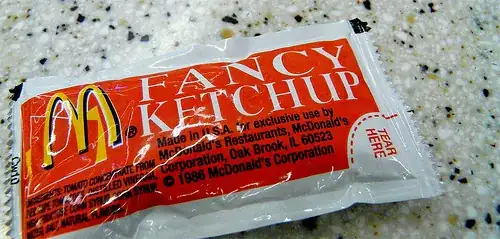"Fancy," when used in the labeling of foods, is almost invariably tied to USDA standards for the classification and grading of the foods. Foods traded on the wholesale market are not required to grade their foods - the use of the system is voluntary. The USDA grading names tied to different food types aren't always consistent or intuitive.
Examples: Vegetable grades, in descending order of quality, are: US Extra Fancy, US Fancy, US Extra #1, and US #1. Fruit grades, in descending order of quality are: US Fancy, US #1, US #2, and US #3. Frozen fruit grades, in descending order of quality are: US Grade A (or Fancy), US Grade B (or Choice or Extra Standard), and US Grade C (or Standard).
Ketchup has its own USDA grading system based partially on the specific gravity of the product - ketchup grades, in descending order of quality are: Fancy, Extra Standard, and Standard. A "Fancy" ketchup isn't all dolled-up in some way, but is likely to have a better and more uniform consistency with fewer undesirable characteristics or flaws than lower grade ketchups.
But, again, just because a ketchup doesn't state that it's "Fancy" doesn't necessarily mean that the contents don't meet the specifications for a fancy ketchup. "Fancy Ketchup" is always "Fancy." "Ketchup" might be fancy quality and not labeled as such.
Yes, there are tomato ketchups that are less fancy than "Fancy Ketchup," but I imagine that the "Fancy" designation for fancy quality ketchups has fallen out of popular usage - except perhaps in the realm of fast food packets where people have become accustomed to seeing it written that way.
